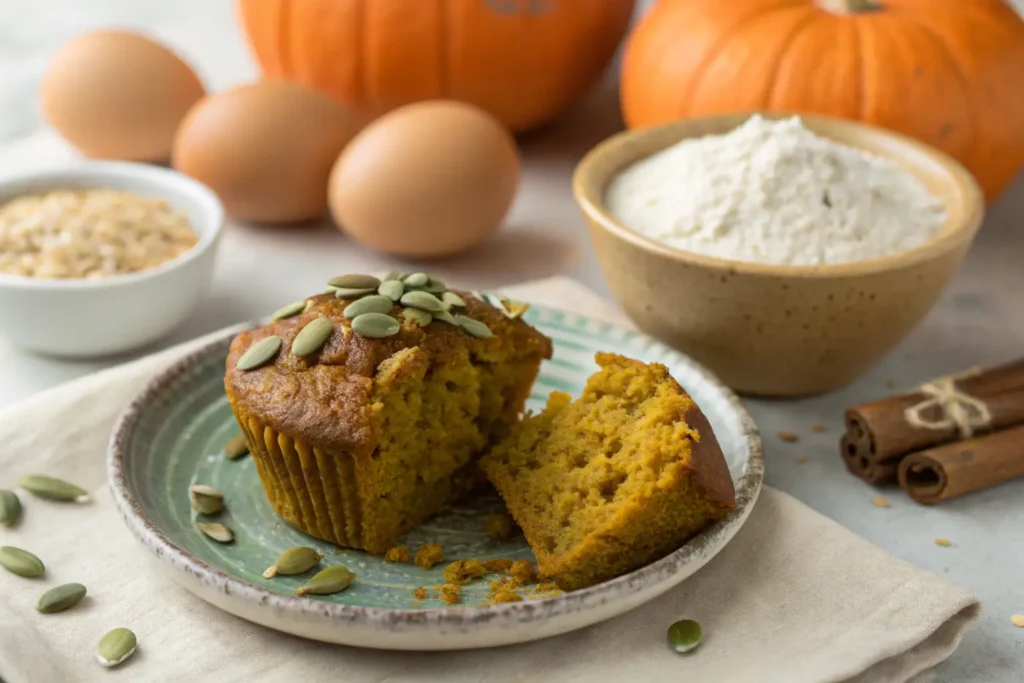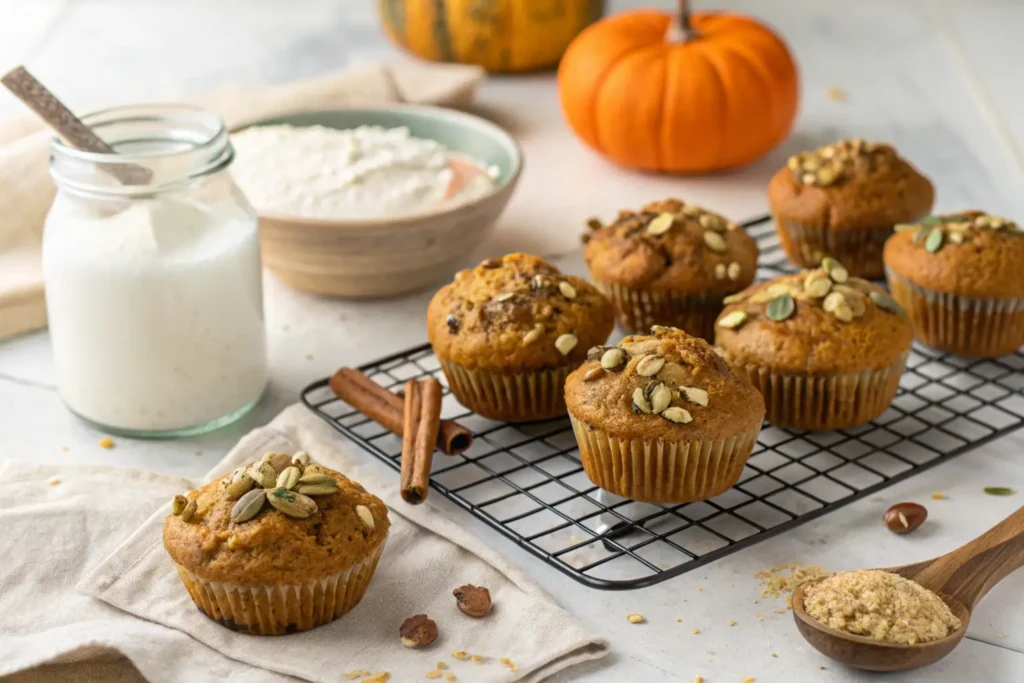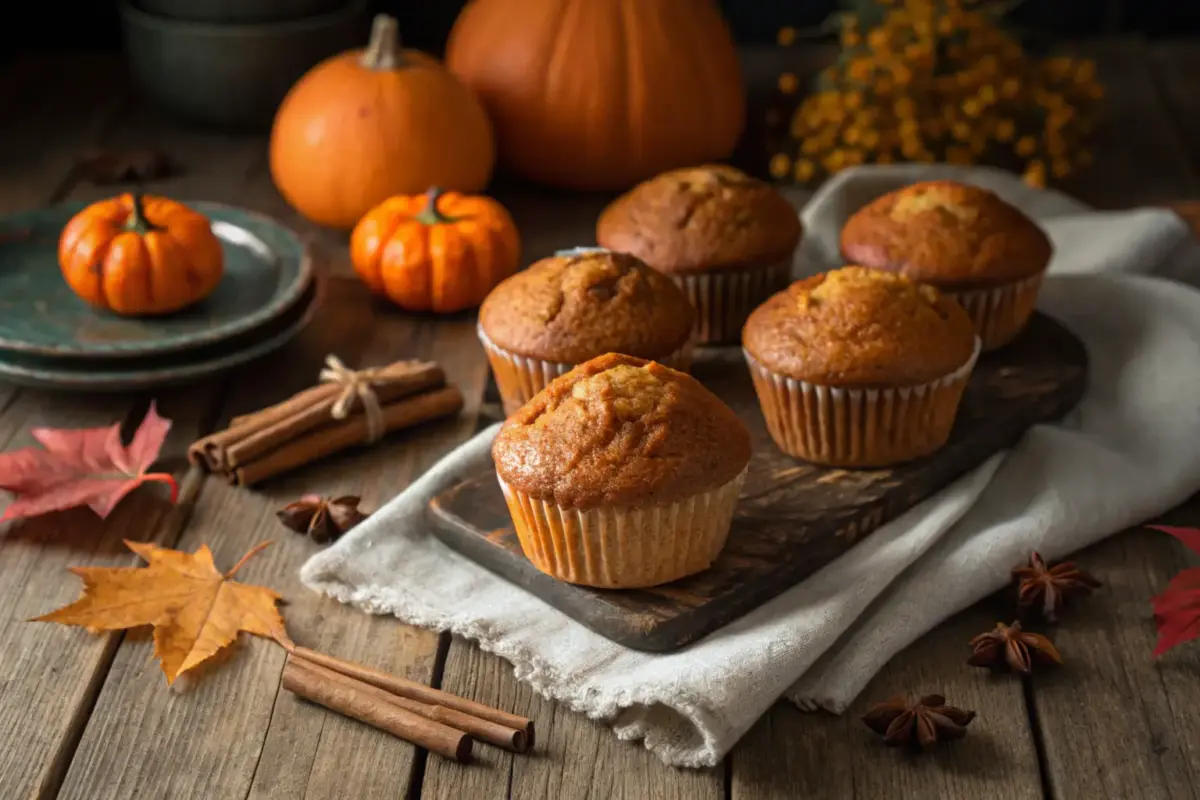Introduction
Ever wondered how much protein is in a pumpkin muffin? These fall-favorite treats aren’t just about their warm, spicy flavor—they also have a surprising nutritional side. Whether you’re grabbing one at your favorite coffee shop or baking a batch at home, understanding the protein content can help you make smarter choices. In this guide, we’ll break it all down so you know exactly what you’re getting with each bite.
We’ll cover everything from the nutritional breakdown of pumpkin muffins to the differences between homemade and store-bought versions. Stick around, because you might be surprised by how much you can pack into these little bundles of pumpkin goodness! For a deeper dive into protein-packed pumpkin muffin recipes, check out this related guide.
Nutritional Breakdown of a Pumpkin Muffin

Overview of Macronutrient Distribution
Pumpkin muffins might feel like a dessert, but they usually fall somewhere between a snack and a light breakfast. Most recipes combine ingredients like pumpkin puree, flour, sugar, and eggs, which give them a balance of carbs, fats, and a bit of protein. However, the actual distribution can vary widely depending on the recipe or brand. Generally, a standard muffin has more carbs than anything else, moderate fat, and low protein levels—around 2 to 5 grams per muffin.
Calories and Serving Size
Here’s the thing: not all muffins are created equal. A regular-sized pumpkin muffin (around 100g) can pack anywhere from 200 to 400 calories, depending on the ingredients. For example, a bakery-style muffin with extra sugar and oil is going to land on the higher end of that scale. On the other hand, a homemade muffin with natural sweeteners and less fat might keep it closer to 200 calories. Paying attention to serving size is also key, especially since jumbo muffins can easily double the calorie count!
Protein Content in Popular Pumpkin Muffin Brands
Store-bought muffins are super convenient, but they’re not always the best when it comes to protein content. Let’s break it down:
- Starbucks Pumpkin Muffin: Roughly 6 grams of protein per muffin, thanks to the addition of eggs and milk.
- Costco’s Pumpkin Muffins: These giant muffins are known for their size and calories, with about 7 grams of protein per muffin.
- Pre-packaged Grocery Store Muffins: Typically around 2 to 4 grams of protein per muffin, depending on the brand.
As you can see, there’s a wide range here, and it often comes down to the ingredients and portion size.
Comparing Homemade and Store-Bought Pumpkin Muffins
Protein Variations in Homemade Recipes
Homemade pumpkin muffins give you full control over what goes in them, which means you can tweak the protein content to match your needs. Adding ingredients like Greek yogurt, protein powder, or almond flour can significantly boost the protein levels. Most basic recipes provide 3 to 5 grams of protein per muffin, but with a few swaps, you can push that up to 8 grams or more!
How Ingredients Impact Protein Levels
The type of ingredients you use makes a huge difference. For example:
- Flour: White flour has minimal protein, while almond flour or whole wheat flour adds more.
- Eggs: Eggs are a natural source of protein and are often a key ingredient in muffin recipes.
- Milk or Milk Alternatives: Regular milk adds a bit of protein, but plant-based options like soy milk or pea milk are even better for a protein boost.
- Extras: Adding chopped nuts, seeds, or even a scoop of protein powder can completely change the protein game.
In short, the more thoughtful you are about your ingredients, the more you can control the nutritional profile of your muffins.
For those who love experimenting with crunchy toppings, granola can add a new dimension of flavor and nutrition. Curious about the science behind it? Learn what ingredient makes granola stick together.
Health Benefits of Pumpkin Muffins
Protein’s Role in Health and Fitness
We all know protein is a big deal, right? It’s essential for repairing muscles, keeping you full, and even helping your body recover after a workout. While pumpkin muffins might not scream “protein-packed,” they can contribute to your daily intake, especially if you tweak the recipe or pick a brand with higher protein content. And let’s face it—finding protein in something that tastes like dessert? Total win!
Plus, when paired with a high-protein topping like almond butter or Greek yogurt, even a low-protein muffin can become a satisfying, balanced snack. Transitioning to protein-focused choices doesn’t mean giving up flavor.
Other Key Nutrients in Pumpkin Muffins
Here’s the good news: pumpkin muffins aren’t just about the protein. Pumpkin itself is packed with vitamins A and C, potassium, and fiber, which makes these muffins a surprisingly nutritious option. The fiber from pumpkin puree can help with digestion and keep you feeling fuller longer. Also, many recipes include spices like cinnamon and nutmeg, which have their own little health perks (hello, antioxidants!).
Even the ingredients you might not think about, like eggs or nuts, can add healthy fats and extra protein, making pumpkin muffins more than just a treat. When enjoyed in moderation, they fit well into a balanced diet.
How to Boost Protein Content in Pumpkin Muffins

Adding High-Protein Ingredients
If you want to pump up the protein in your pumpkin muffins, start by mixing in high-protein ingredients. Here are some simple swaps and additions:
- Protein Powder: Adding a scoop or two of your favorite protein powder is one of the easiest ways to boost protein. Just remember to balance it with extra liquid to avoid dry muffins.
- Greek Yogurt: Swap out some oil or butter for Greek yogurt. It not only adds protein but also keeps the muffins moist.
- Nuts and Seeds: Walnuts, almonds, or pumpkin seeds add a nice crunch and extra protein. They’re like sprinkles—but healthier!
- Cottage Cheese: It might sound odd, but blending cottage cheese into the batter can add protein without changing the flavor much.
By combining a few of these options, you can easily create a muffin that’s both delicious and more nutritious.
Substituting Traditional Flour for Protein-Rich Alternatives
Another easy way to amp up the protein is by swapping out traditional flour for alternatives. For example:
- Almond Flour: It’s naturally higher in protein and gives muffins a nutty flavor.
- Coconut Flour: While it’s lower in carbs, it contains some protein and adds a unique texture to baked goods.
- Oat Flour: Made from ground oats, it adds a bit more protein and fiber compared to white flour.
If you’re not ready to fully commit to a flour swap, you can always do a 50/50 mix with regular flour. That way, you get the benefits without sacrificing the light, fluffy texture that makes muffins so irresistible.
Pumpkin Muffins in Specific Diets
Are Pumpkin Muffins Suitable for High-Protein Diets?
Okay, let’s talk macros. If you’re following a high-protein diet, pumpkin muffins probably aren’t the first thing that comes to mind. But with a few tweaks—like the ones we mentioned above—they can absolutely fit into your plan. The key is to focus on recipes or brands that prioritize protein-rich ingredients and keep the sugar to a minimum. Pairing a muffin with a high-protein beverage or snack can also help balance things out.
The key is focusing on recipes or brands that prioritize protein-rich ingredients and keep the sugar to a minimum. Wondering how pumpkin muffins compare to other treats? Check out what donut has the most protein for an interesting comparison.
Vegan and Gluten-Free Options
If you’re vegan or gluten-free, pumpkin muffins are still on the table! In fact, many vegan recipes use plant-based milk and flaxseed “eggs,” which can add a little protein. For gluten-free options, swapping in almond or oat flour not only eliminates gluten but also adds protein and fiber.
Looking to go the extra mile? Use pea protein powder or a soy-based milk alternative for even more protein in your vegan, gluten-free muffins. It’s all about making simple adjustments to fit your dietary needs without sacrificing flavor.
Popular Variations of Pumpkin Muffins
Protein Content in Vegan Pumpkin Muffins
Vegan pumpkin muffins have come a long way, and they’re no longer just about avoiding animal products. Today, many vegan recipes prioritize protein by using ingredients like soy milk, almond flour, or even chickpea flour. These substitutions not only make the muffins plant-based but also add a nice protein boost. On average, a vegan pumpkin muffin can have around 4 to 6 grams of protein, depending on the recipe.
Want to level up? Add a handful of chopped nuts or a scoop of plant-based protein powder to the batter. Trust me, you won’t even notice the difference in texture, but your protein count will thank you!
Low-Sugar High-Protein Pumpkin Muffin Recipes
If you’re watching your sugar intake but still craving the warm, spicy goodness of pumpkin muffins, you’re in luck. Low-sugar recipes often rely on natural sweeteners like mashed bananas or a touch of maple syrup, cutting down on processed sugar. Combine that with protein-rich ingredients like Greek yogurt or almond flour, and you’ve got a healthier version of your favorite treat.
These recipes typically contain anywhere from 7 to 10 grams of protein per muffin, making them a fantastic snack or breakfast option. Bonus: low-sugar muffins also pair perfectly with high-protein spreads like peanut butter or cottage cheese for an extra boost.
Tips for Choosing a Healthier Pumpkin Muffin
What to Look for in Store-Bought Options
Let’s face it—sometimes, you just want the convenience of store-bought muffins. The good news is, healthier options are out there; you just have to know what to look for. Start by scanning the ingredient list. Muffins made with whole grains, natural sweeteners, and added protein (like whey or pea protein) are your best bets. Also, check for extras like nuts or seeds, which can contribute healthy fats and protein.
As a rule of thumb, aim for muffins with at least 5 grams of protein and less than 10 grams of added sugar per serving. That way, you’re getting the flavor you love without overloading on empty calories.
Reading Nutritional Labels Effectively
Navigating nutritional labels can feel like a chore, but it’s worth it if you want to make smarter choices. Pay close attention to these key details:
- Protein: Look for muffins with at least 5 grams of protein per serving.
- Calories: A healthy range for a muffin is between 200 and 300 calories, depending on your dietary goals.
- Sugar: Stick to options with less than 10 grams of added sugar.
- Ingredients: Prioritize muffins with whole, recognizable ingredients like whole wheat flour, pumpkin puree, and natural sweeteners.
By focusing on these factors, you can enjoy pumpkin muffins without feeling like you’re compromising your health goals.
FAQs
How much protein does a Pumpkin Muffin have?
The protein content of a pumpkin muffin can vary widely. Store-bought versions typically have 2 to 6 grams of protein, while homemade recipes can reach up to 8 grams or more if you include high-protein ingredients like Greek yogurt or almond flour.
Are muffins a good source of protein?
Muffins generally aren’t considered a high-protein food, but with the right recipe tweaks, they can be. Adding protein-rich ingredients like eggs, nuts, or protein powder can make muffins a more balanced snack or breakfast option.
How many calories are in a small homemade Pumpkin Muffin?
A small homemade pumpkin muffin typically contains around 150 to 200 calories, depending on the ingredients. Using natural sweeteners and whole-grain flours can help keep the calorie count reasonable while adding nutritional value.
How much protein is in pumpkin bread?
Pumpkin bread usually has slightly less protein than muffins because it often lacks the added protein boosters. On average, a slice of pumpkin bread contains 2 to 4 grams of protein. However, recipes can be modified to increase the protein content, just like with muffins.
Conclusion
When it comes to pumpkin muffins, there’s a lot more to them than just their irresistible taste. By understanding their nutritional profile, experimenting with high-protein ingredients, and making informed choices, you can enjoy these fall favorites while staying aligned with your health goals. Whether you’re baking at home or picking up a batch at the store, a little planning goes a long way. So go ahead, savor that muffin—you deserve it!


3 thoughts on “How Much Protein Is in a Pumpkin Muffin? A Complete Guide”